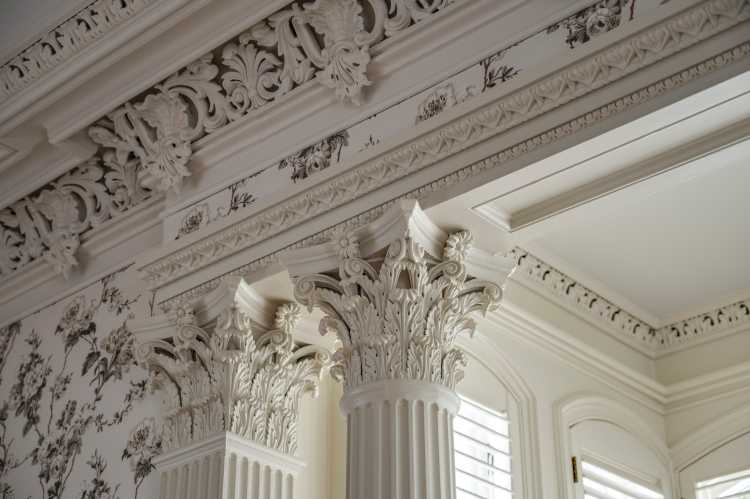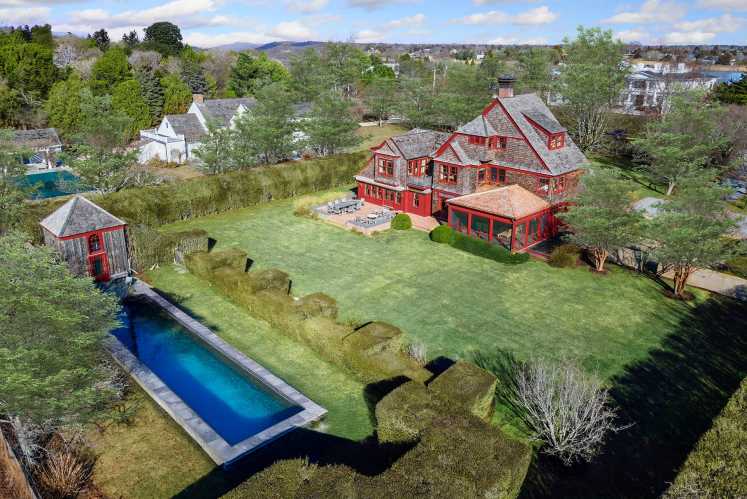The Hamptons have a history rooted far beyond when it got its nickname. English Puritans first settled here in the 17th century, building homes, some of which have been preserved.
Historic homes, those at least a century old, are not uncommon, though many have been razed for one reason or another. Still, many have been cherished, given facelifts by those who appreciate historic character, and often, it begins with the real estate agent, who can help shape a historic house’s future and provide vision for the home’s potential.
“There is certainly a sector of the buyer pool who cares about ‘a story’ or the lineage of ownership,” says Tim Davis, one of the top producers at The Corcoran Group. “This can unfortunately be lost on some, who are focused solely on ‘the new’ at the expense of honoring our region’s fascinating past.”
Davis, a lifelong South Fork resident with 44 years in real estate, has sold many significant homes with history, including the Linden Estate in Southampton Village, which they sold with Harald Grant of Sotheby’s International Realty in 2022 for $70 million, the most ever paid for a nonwaterfront property in the Hamptons. The sale of the 18,000-square-foot residence, which sits on 10 acres, shows history can come with a hefty price tag.
Jack Pearson, co-founder of the CeeJackTeam at Compass, has sold many historic homes in Sag Harbor Village, steeped in history with an architectural array of the last two centuries.
“The CeeJackTeam is known for representing sales of these historic homes, for we ourselves live in them and can appreciate and speak to their uniqueness to our clients,” he says. “They tell a story of time and lives lived, and it is important to preserve them and sell them to those who appreciate how special they are.”

An Appreciation of the Past
Beyond making a real estate investment, those who purchase historic homes are getting much more.
“History provides a story and specialness to our clients,” Pearson says. “These homes appeal to a certain clientele that appreciates that.”
When selling these historically significant properties, he says it’s up to the agent to “illuminate the architectural style and features of the house specifically to engage the clientele and have them appreciate what they are seeing.”
So, exactly what kind of buyer is attracted to these types of homes?
“Generally, someone who appreciates architecture and history and who is also willing to live with some of the quirks that come with a historic house,” Davis answers.

He happens to be one of them.
“I bought an 1855 house in Newport, Rhode Island, five years ago and completed a 15-month renovation,” he shares. “I fell in love when I walked in the front door. My goal was to make improvements for how the house lives today, while also honoring the architecture and vision of the original builder. For me, I view my ownership as being a steward in the life of this home and someday, someone else will take over that role.”
A similar buyer here on the East End could do exactly that for one of the most important historic homes in Sag Harbor, which is back on the market this spring, after it did not sell last year with a different brokerage. The Hannibal French House, a national landmark, is now listed with Susan Breitenbach of Corcoran and asking $17,995,000.
Prominently located at 186 Main Street, the Captain’s Row house was originally built in the 1790s and later acquired by whaling fleet owner Hannibal French.
An 1860 addition was overseen by Minard Lafever, an early 19th-century architect with several designs part of the National Register of Historic Places, such as the Old Whalers Church in Sag Harbor. In 1948, the mansion was purchased by Charles Edison, the former Governor of New Jersey and the son of inventor Thomas Edison. Under his ownership, he undertook a major restoration of the house.
Today, the Victorian Italianate home boasts 6,500 square feet of space reimagined by renowned British designer Veere Grenney. It features Sag Harbor’s only formal ballroom, an elegant dining room and a gourmet kitchen with a marble island and high-end appliances. There are seven bedrooms, four bathrooms, two half bathrooms and a whopping 10 fireplaces.
Set on 0.59 acres of manicured grounds with a covered deck, the house enjoys privacy thanks to towering trees, as well as a heated gunite pool.

Attention to Detail Not Found Today
In Southampton, Davis is looking for a buyer for 3 Fair Lea, an enclave just south of Southampton’s Gin Lane, asking $18.5 million. It is a co-exclusive with Michaela Keszler of Sotheby’s International Realty.
Built in 1883 and known as Clover Top, the home is one of six original cottages that were part of Alfred Nelson’s Fair Lea compound. It is also one of the few to come with a deeded path that leads directly to the Atlantic Ocean.
The 1.27-acre, gated property is sure to take you back to a time gone by when aristocrats flocked to their “summer cottages,” now just with 21st-century upgrades. Historic elements include a hand-carved staircase, a third-floor that includes a bedroom and the wraparound porch ideally positioned to catch the ocean breeze in summer.
The historic Rosemary Lodge in Water Mill, one of the most architecturally unique homes in the Hamptons and listed on the National Register of Historic Places, came to the market recently, listing at $14.25 million with Brown Harris Stevens agent Steven Dorn.

Montauk Highway, now sits facing south on Rose Hill Road.Courtesy of Brown Harris Stevens
It was built in 1884 by Reverend Henry Turbell Rose, who came from Lowell, Massachusetts, on a half-acre of farmland he purchased from his uncle for $50. History has it that Rose paid architect Frederick W. Stickney of Lowell $25 for a house design, though he completed much of the work himself. A rear addition was put on in 1904.
The shingle-style house, with its early English and Craftsman influences, was moved in 1985 from its original location closer to Montauk Highway, further south. At that time, architects R. Allan Cordingly and Elford A. King, who had already owned Rosemary Lodge for 20 years, reoriented the house at its current location on Rose Hill Road, facing south on a 0.93-acre parcel.
“Rosemary Lodge is one of the last great legacy estates in the Hamptons,” says Dorn. “The craftsmanship and attention to detail are just not found in homes these days. It’s a very special place.”
It was added to the National Register of Historic Places in 2000 as a “museum quality” example of shingle-style architecture, characterized by asymmetrical massing and an irregular outline.
“Modern additions include a porch and dormer on the west side of the north wing, an in-ground swimming pool, and some replacement casement windows,” according to a history of the house. The five-bedroom, four-and-a-half-bath home was meticulously renovated in 2007.
Rosemary Lodge, now a 4,110-square-foot residence, has retained much of its original details, including paneling, hand-carved woodwork, stained glass windows and intricate moldings, with each room featuring a distinct type of wood.
The central living hall, paneled in ash, sets the tone for this architectural gem, the listing description says.
Four working fireplaces feature hand-carved mantels, hidden cupboards, hand-painted designs and custom tile inserts. Throughout the home, delicate floral motifs, ships, butterflies, and birds are carefully etched into the wood, along with the initials “RL.”
In addition, “There is poetry literally carved into the walls, including works by Shakespeare,” Brown Harris Stevens says. Designed for elegant entertaining, the chef’s eat-in kitchen is equipped with a professional gas stove with a broiler, as well as a massive center island. There is seamless access to the outdoor lounge and dining area.
The primary suite, which can be found on the second floor with two other bedrooms, boasts a spa-like en suite bath, a spacious walk-in closet and a terrace overlooking open land. A second-floor media room holds a big-screen television and a fireplace. The grounds include an expertly maintained rose garden at the entrance and a lush backyard oasis around the heated pool.

Marketing Is Key
“When marketing a historically significant property, I find it important to highlight a mix of history and newer improvements, which have been made to the house,” says Davis. “Pictures do tell a thousand words, so photography is very important and needs to position the home in the best light while also being transparent. To that end, thoughtful staging can be beneficial.”
Davis says ultimately it comes down to how well the home has been maintained. “The value, charm, and even historic provenance is certainly a big selling point. However, it depends on the overall condition of the house. Historic properties that have already seen significant updates and improvements are more appealing to many buyers.”
The reason, of course, comes down to cost and convenience for most buyers. “Sometimes there are restrictions on making architectural changes to these homes, which can drive the renovation cost up and make the process more challenging,” he notes.
Buyers are concerned about changes they may want to make to reflect their lifestyle or needs. Any restrictions around improvements and expansion can be a drawback to considering a historic property.

However, there are benefits, often the catalyst of time and space that no longer exist. “There are frequently zoning preferences that exist with older historic homes and their settings. Often, they offer lush mature landscaping, greater setbacks with more privacy, and larger lots, for example,” Davis explains.
For instance, Davis represents a historic Quogue home on 1.14 acres that recently underwent a five-year restoration. Designed and built in 1890, it represents one of the finest examples of Second Empire/French Mansard architecture in the Hamptons, he adds.

The residence at 84 Quogue Street, listed at $6.95 million, was expanded and now enjoys modern conveniences after the renovation. The 5,500-square-foot home offers the best of both worlds, he says.
For Pearson and the CeeJackTeam, he says they relish in selling the history of the Hamptons and conveying “the spirit and beauty that history provides in architecture.”

He finds, “Often potential buyers want to know how they can upgrade or improve a home while keeping its special character. We can connect them to some of the most talented and sensitive designers and architects in the business who can intuitively speak to modern living while embracing what’s untouchably special about living in a piece of history.”
Pearson’s team has two historic properties currently on the market, both in Sag Harbor Village, both of which enjoy accessory structures, always a premium in the village with its smaller parcels.
Known as the Bramble House at 16 Redwood Road, the cottage was built in the 1800s by John Bramble, a son of the Revolution. The 1,500-square-foot house has been renovated by the founders of Ash, an AD100 design firm, to feature a double-height kitchen, originally a butcher shop floated from North Haven, with a decorative wood-burning stove. The living area showcases windows of striking leaded glass, salvaged from a Manhattan church.
The 0.33-acre property holds a heated gunite pool, a deck with a pergola and a potential accessory structure with a bathroom, which could make a studio, workspace or poolhouse.
The asking price is $2.995 million.
Over at 156 Jermain Avenue, the cedar-shingle home dates back to around 1900. While it has undergone renovations, such as to the kitchen and bathrooms, it has retained its historic charm with elements such as the original pressed tin ceiling and a rare windowed attic space that has tremendous potential.
A separate studio space toward the rear of the 0.11-acre property was reimaged already by a notable designer, who installed new slate floors and historic French windows and doors. The flex space could be a dining pavilion, a home office, or an exercise studio. Also of note, the backyard abuts the front yard of a neighbor down a flag drive, so there will never be anything built there, providing a quiet space.
Listed at $1,895,000, the 1,800-square-foot home also comes with two coveted off-street parking spaces, a premium that is close to the village center.
This article appeared in the Memorial Day weekend issue of Behind The Hedges in Dan’s Papers. Read the full digital edition by tapping here.






















